Rigging Small Sailboats
Chapter 5
.....running rigging
Page 4|
FIGS. 5-10 through 5-13 show various jib sheet configurations. Jib sheets are usually two part lines secured at the mid length to the jib clew cringle usually via a shackle. This means that the hardware to control one side of the jib sheet will be duplicated for the other side; in other words, each side of the boat will have the fittings shown. |
|
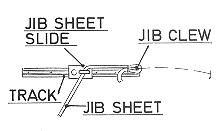
FIG. 5-10-A fairlead on a slide allows adjustment of the jib sheet lead point via the track. The sheet can be hand held or belayed to a cleat at some convenient point. |
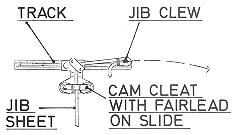 FIG. 5-11-Similar to the foregoing but the line is belayed with a cam cleat mounted directly on a slide which runs on the track. |
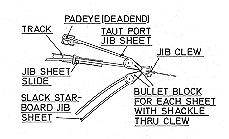
FIG. 5-12 - This system provides a power advantage of 2 to 1 (before allowing for fiction) to the jib sheet. The pad eye is mounted outboard of the track and two bullet blocks are shackled to the sail (one for each sheet for each side of the boat). The line then passes through a fairlead slide on a track and then aft to a jam or cam cleat. Optionally, the cam cleat could be mounted on the slide as for Fig. 5-11. |

FIG. 5-13 - This jib sheeting method gains power through the use of a winch. The power of such a rig is directly dependent on the power of the winch that can be varied to suit. A fairlead on a slide could be used on the track, however, the swivel block reduces friction and chafe. A snubbing winch is shown in this example, although a winch with a handle can be used. The line must be belayed to a cleat beyond the winch. Note that the lead from the swivel block to the winch is fairly horizontal, as it should be. |
JIB SHEET LEAD
The sheet used to control the jib must be lead to a point on the boat that affords optimum setting of the jib (if one is used). If a Genoa jib is used, a separate sheet lead must be determined for this sail also. Since the jib sheets are in two parts (one for starboard, and the other for port), a lead point will be located on each side of the boat. In determining the lead points, the designer probably uses a formula similar to that shown in Fig. 5-16, which is at best always an approximation. Because methods used to determine jib sheet leads are approximations, and because no two sails will trim the same, it is best to make the sheet lead point adjustable by using lengths of tracks and sliding fittings attached to them. Another method for determining the jib sheet lead, at least on small boats, is to actually sail the boat with the jib in position and thereby determine the optimum setting in actual use. When the optimum point has been located, mark with a pencil and attach the appropriate fittings to the deck.
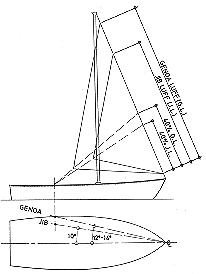
FIG. 5-16 - A common method used for locating the jib and Genoa sheet leads is graphically shown. The results are usually acceptable, but it is wise to use tracks so minor variations in sheet lead can be made. |
DOWNHAULS AND BOOM VANGS
Not all boats use downhauls or boom vangs, but they are used enough to warrant discussion. A DOWNHAUL is merely a line used to haul down on something, usually the tack of the sail, or the boom where the tack of the sail is located (see Fig. 3-12). A boom downhaul fitting or eye is often a part of the sliding gooseneck, to which the downhaul is attached to prevent the gooseneck from sliding up the mast. Once the sail has been hoisted with the halyard and pulled taut to a cleat, the downhaul can be used to gain further tension along the luff of the sail by pulling down and making fast to a cleat. Naturally, a similar downhaul could be used on the jib. A special type of downhaul called a "CUNNINGHAM" requires that the sail have an additional cringle usually located several inches above the tack cringle. The "Cunningham" is usually used on competition boats where more shape control of the sail is desired along the luff, but because of the racing rules, the boom cannot be hauled down below a certain pre-designated point.
A BOOM VANG (also called a "go faster" and "kicking strap") is a device that performs several functions. The boom vang is a tackle arrangement (see Figs. 5-17 and 5-18) connected at one end to the mast near its base, and with the other end preferably about 1/3 the distance of the boom aft of the mast. The boom vang helps take the undesirable "twist" out of the sail on all courses off (or away) from the wind, flattens the mainsail on a tack (sailing in the direction of the wind), and prevents the boom from lifting in case of accidental jibes (the boom moving rapidly from one side to the other when sailing downwind).
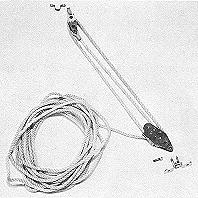 |
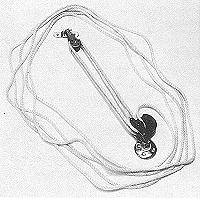 |
|
FIG. 5-17 & 5-18 - Two boom vang tackles with fittings. The upper block is attached to the boom, while the lower block is fastened to the mast base or near the mast base on deck. These boom vang tackles could also be used for mainsheet rigs if desired. Fig. 5-17 (left) has a power ratio of 3 to 1. Fig. 5-18 (right) has a power ratio of 4 to 1. |
|
HOW TO FIGURE A TACKLE
In order to figure a tackle to control a mainsail, for example, you must first know the area of the sail. Once the area of the sail is known, figure the "load" caused by the wind on the sail. In figuring for a mainsail which has the mainsheet lead at the end of the boom, figure wind load by multiplying the sail area by 1.5 lbs. per square foot. If the mainsheet leads to the boom midpoint, multiply the sail area by 3 lbs. per square foot. (For figuring the jib or Genoa, also multiply by 3 lbs.) Actually, these factors are only estimates by rule-of thumb and allow a safety factor in consideration of varying sailing conditions, rig designs, and wind forces up to 20 knots, but the results will usually be close enough.
If, for example, a mainsail has 100 square feet of area, the mainsheet load at the end of the boom would be 100 square feet multiplied by 1.5 lbs. and would equal 150 lbs. Obviously, in order to control this sail it would require 150 lbs. of "pull" at times on the sheet. So to reduce this effort, we devise a tackle. But how many "parts" should be included in the tackle? Again a rule-of-thumb is used which says that most people can pull 30 to 50 lbs. on a line BY HAND. If using a cam cleat on the end of a line, this figure can be increased, say up to 75 lbs. or more for he-man types! But, in most cases, it is good to stick to the 30 to 50 lb. range, if practical.
The ability of a tackle to do work
depends on the number of "parts" or lengths of line BETWEEN the
blocks as shown in Fig. 5-3. The more parts, the easier will be the job, but
consequently the longer will be the length of line AND TIME to move the load or
boom a given distance. To determine the effort required on the line when rigged
in the tackle, divide the total wind load by the number of parts in the tackle.
For example, using our 100 square foot sail, divide the wind load of 150 lbs.
by 4 (if we wanted a 4-part tackle) and arrive at 37.5 lbs. of pull required to
move the boom or load. However suitable this figure may be, we must DEDUCT a
certain amount that will be lost due to friction caused by the sheaves in the
blocks, and other factors that take away from our gain in mechanical advantage.
Again another rule-of-thumb is used which figures a 10% loss for every sheave
used in the tackle. Therefore, with a 4-part tackle which has four sheaves,
multiply each sheave by 10% for a total of 40%, which is then multiplied
against the total wind load (40% x 150 lbs.) for a total of 60 lbs. lost to
friction and other losses. (While the 10% figure is not technically exact, it
is close enough to use as a practical short cut, and it does yield conservative
results.) To the result (60 lbs.) add 150 lbs. (wind load) for a total load of
210 lbs. Divide this figure by the number of parts in the tackle (4) for a
result of 52.5 lbs., or just about the maximum for holding a sheet by hand in a
20 knot wind. If we use a jam cleat to secure the sheet, this tackle will prove
sufficient to do the job under just about all conditions short of having to
reduce sail area. This example can be used to figure other tackles as well. In
summary:
SAIL AREA X FACTOR (1.5 OR 3) divided by NUMBER OF PARTS IN TACKLE EFFORT
(BEFORE FRICTION LOSS).
To figure power loss in tackle:
WIND LOAD X 10% PER SHEAVE FRICTION LOSS; WIND LOAD + FRICTION LOSS = TOTAL
LOAD IN LBS.
To figure load on end of sheet which crew must handle:
TOTAL LOAD IN LBS. divided by NUMBER OF PARTS IN TACKLE = LOAD IN LBS. AT END
OF SHEET.
To be continued in next WebLetter